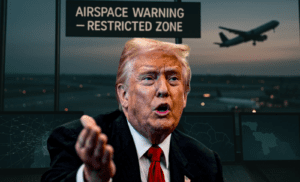With the 2025 Atlantic hurricane season shaping up to be one of the most active in recent memory, all eyes are on the Gulf Coast. According to the National Oceanic and Atmospheric Administration (NOAA), this year’s forecast includes 13 to 19 named storms, 6 to 10 hurricanes, and up to 5 major hurricanes (Category 3 or above). While the predictions alone are enough to stir concern, what makes this season particularly fraught is the dramatic shift in how the federal government now handles natural disasters under President Donald Trump’s second administration.
The Trump administration, guided by the conservative “Project 2025” blueprint, has significantly restructured the Federal Emergency Management Agency (FEMA). The changes—designed to streamline federal operations and hand more responsibility to state governments—have been met with both political praise and operational skepticism. FEMA’s staffing has been slashed by 35 percent, the acting administrator was dismissed in early 2025, and a new veteran-led initiative dubbed “FEMA 2.0” is underway. Whether this scaled-back federal model can handle back-to-back hurricanes remains the open question.
To assess the stakes, one must only look back.
Lessons from the Past: Katrina and Harvey
When Hurricane Katrina struck New Orleans in 2005, it overwhelmed every level of government. The levee failure was catastrophic. The federal response was widely condemned as slow and inadequate, with FEMA, under President George W. Bush, scrambling to organize logistics in the chaos. Over 1,800 lives were lost. The storm revealed the danger of delayed federal coordination during large-scale disasters.
Fast forward to 2017, when Hurricane Harvey devastated Houston, Texas. In just a few days, the storm dumped over 50 inches of rain, submerging highways and homes, causing $125 billion in damage. FEMA, then under the Department of Homeland Security, launched an enormous response—coordinating shelters, emergency relief, and rebuilding funds. The storm tested both the scale and flexibility of America’s disaster apparatus. Despite logistical challenges, FEMA’s presence was essential in facilitating recovery.
These two events underscore a critical truth: when hurricanes of record-breaking strength hit densely populated cities, state and local governments alone often lack the scale, budget, or logistics network to respond adequately. This is not due to incompetence, but to the sheer magnitude of natural disasters in the 21st century.
Trump’s New FEMA: Smaller, Leaner, State-Led
In contrast to previous administrations, President Trump has overhauled FEMA to align with his broader decentralization agenda. Following recommendations from the Heritage Foundation-backed Project 2025 plan, FEMA is being reimagined as a limited federal body, stepping in only after states exhaust all options. Acting Administrator David Richardson—a former Marine—has championed a leaner approach, stressing that “states are the first line of defense” in all emergencies.
Homeland Security Secretary Kristi Noem has even floated renaming FEMA entirely, suggesting the agency should play more of a support role while placing the financial and operational burden on state capitals.
This ideological shift reflects a deeper transformation in governance: one where Washington acts as a backstop, not a front-line responder. But this poses risks—especially in disaster-prone states like Louisiana, Florida, and Texas, where storms regularly test infrastructure and planning.
Already, warning signs are emerging. In Mississippi, tornado survivors reported delayed federal aid due to what critics say is a more cumbersome application and review process. Meanwhile, NOAA—tasked with monitoring and predicting storm development—has also faced budget cuts, raising concerns about the accuracy and timeliness of forecasts.
The Stakes for 2025
With above-average sea surface temperatures, ENSO-neutral conditions, and a robust West African monsoon—ideal ingredients for storm formation—the Gulf Coast is again in the crosshairs. Texas alone has seen some of the worst hurricanes in U.S. history, from the Galveston Hurricane of 1900 to more recent disasters like Ike and Harvey. Louisiana is equally vulnerable, as demonstrated by Katrina and Ida.
Should multiple storms make landfall this year, the question is not only how well each state can respond, but how quickly FEMA can supplement those efforts. While decentralization may sound appealing on paper, disasters do not respect jurisdictional boundaries or state budgets.
A weakened FEMA, even with the best intentions, may struggle to coordinate cross-state logistics like emergency evacuations, fuel distribution, and search and rescue missions. Moreover, low-income communities—often the hardest hit—rely on federal programs for post-disaster housing and financial relief. Delays or gaps in those services can have life-or-death consequences.
Balancing Reform with Readiness
To be fair, some decentralization has merit. State and local agencies often understand their geography, demographics, and logistics better than federal counterparts. Empowering them with more autonomy and funding could yield more tailored responses. But that only works if federal capacity remains robust enough to serve as a true safety net when overwhelmed.
As hurricane season ramps up, bipartisan calls are growing louder to ensure FEMA maintains operational readiness. The U.S. Senate Committee on Homeland Security has requested updated FEMA readiness reports. Several governors, including Republicans in coastal states, have warned that shrinking FEMA’s role too much could backfire.
In Houston, Mayor John Whitmire has announced that the city will not rely on “promises from Washington” this year and is boosting its own emergency funding. But even the most resilient cities can only do so much.
Politics Can’t Weather the Storm
Hurricanes don’t care about politics. They don’t wait for state agencies to file paperwork or for federal councils to review new emergency protocols. They arrive with wind, water, and chaos. And when they do, the response must be swift, unified, and large-scale.
President Trump’s efforts to reduce federal bureaucracy and return power to the states follow a clear ideological roadmap. But in a season where five major hurricanes could strike, the U.S. may be forced to confront whether this model can stand the test of nature’s fury.
If FEMA fails under pressure or states are left to fend for themselves with insufficient support, the consequences will not be theoretical—they will be measured in destroyed homes, broken levees, and lost lives.
America cannot afford to relearn the same hard lessons from Katrina and Harvey. Reform must never come at the cost of readiness.
















